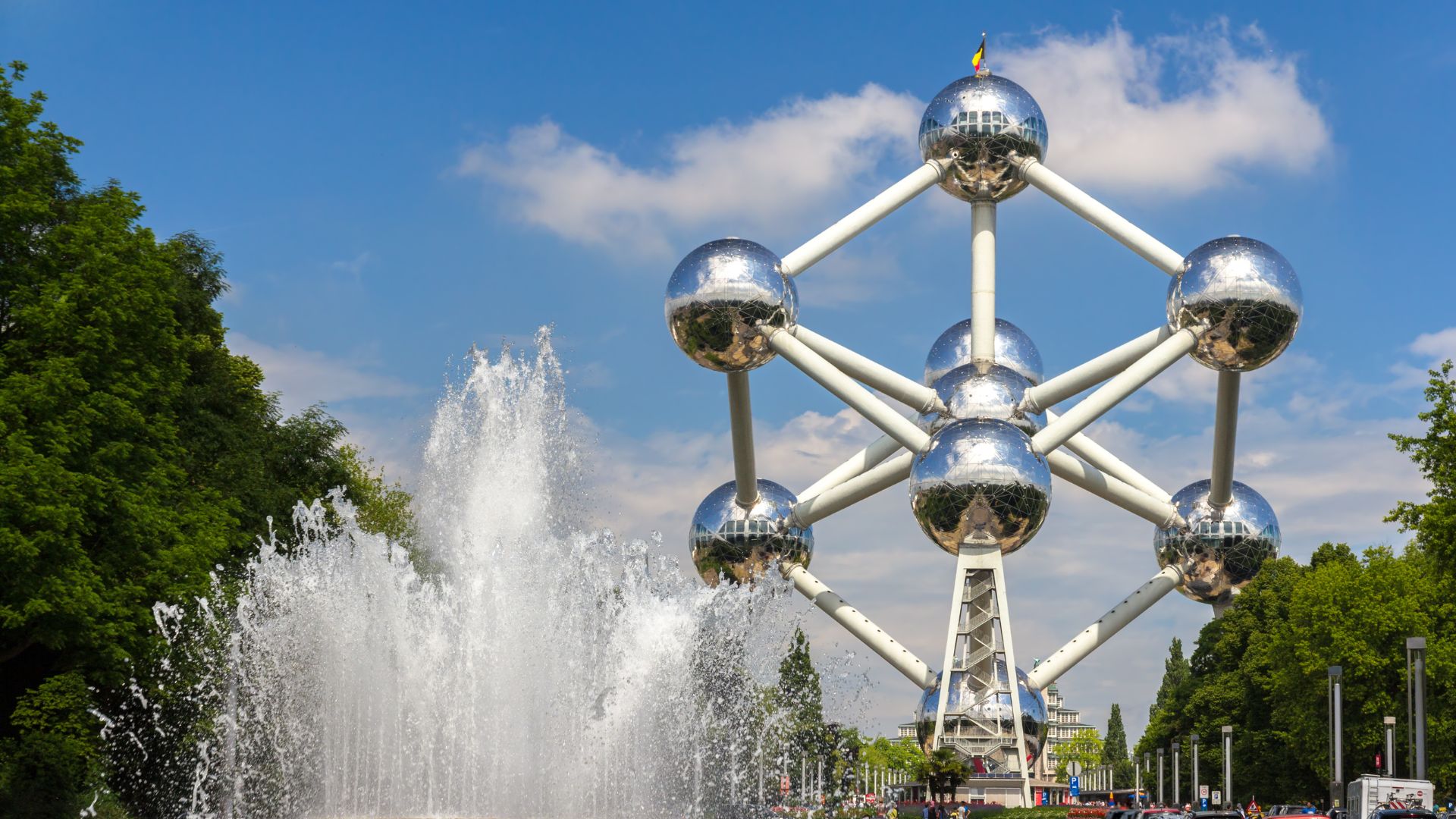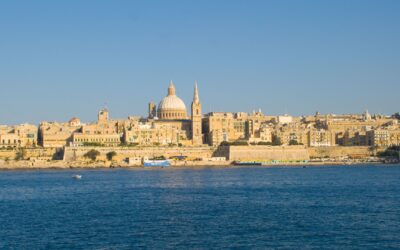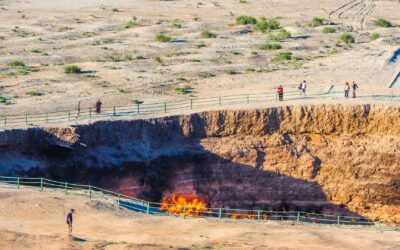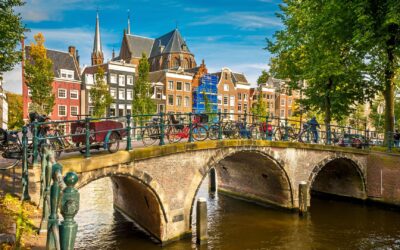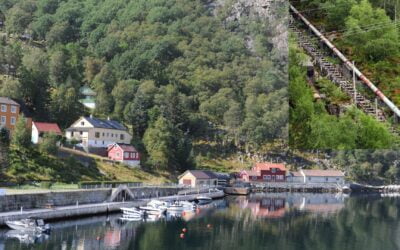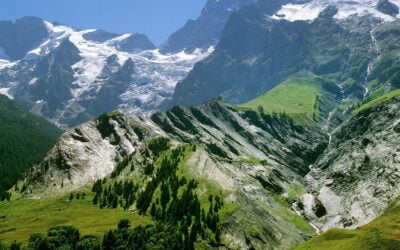Planning a vacation in Europe and thinking of doing something a bit different from the usual? Alternatively, do you find yourself in a new location and wondering if there’s anything a little bit quirky to see or do? If the answer is yes to either of the questions, I have a list that should come in handy. Think of weird places, strange traditions, odd or silly museums and buildings, and rather cool underground structures. Here is a list of some quite unusual European destinations.
The Museum of Witchcraft and Magic, Boscastle, England
Let’s start with some witch stuff, shall well? The Museum of Witchcraft and Magic hosts one of the world’s largest collections of items related to witchcraft, magical practices, and folklore. Here you can find all sorts of artifacts associated with folk magic, ceremonial magic, and Wicca, such as a wise woman’s cottage recreation, witch-hunting instruments, and a two-headed pig in a jar. So, if witch motifs are your thing and you can spend a few hours in Cornwall, then this museum might be a magic spice for you.
Getting there: You can reach the Museum of Witchcraft and Magic by flying to Boscastle is Newquay Airport, located about 33 km (21.7 mi) from Boscastle. Exeter Airport and Bristol Airport are also nearby, at 90 km (56 mi) and 159 km (99) mi respectively. If you are traveling by train, the nearest major train station is Bodmin Parkway. From there, you can take a taxi or a bus to Boscastle. This train station is connected to various parts of the UK, including direct train services from London Paddington.
Electric Ladyland, Amsterdam, Netherlands
If minerals that glow under violet light are your thing, consider visiting the Electric Ladyland the next time you visit the cool city of Amsterdam. Founded by American artist Nick Padalino in 1999, the museum showcases an array of both natural and man-made objects that exhibit vibrant colors when exposed to different light wavelengths. Will you be able to figure out which objects are man-made and which aren’t?
Getting there: Electric Ladyland is easily accessible from central Amsterdam. If you are near the Anne Frank House, it’s just a 5-minute walk. From Amsterdam Central Station, it’s a 20-minute walk.
Baby Jumping Festival (El Colacho), Castrillo de Murcia, Spain
The Baby Jumping Festival, known as “El Colacho,” is a traditional Spanish event held annually in Castrillo de Murcia since 1620. It coincides with the Catholic feast of Corpus Christi. During the festival, men dressed as Mr. Devil (known as “El Colacho”) jump over infants who were born in the previous year and are laid on mattresses in the street. Pretty weird but keep in mind this ritual cleanse the babies of the original sin, protects them against illness and evil spirits, and ensures their safe passage through life. Or so they say. Whether you believe the ritual is effective or not in accomplishing its original purpose, you may find it fun to watch or even become an El Colacho yourself.
Getting there: Castrillo de Murcia is a small village in the Burgos province of northern Spain. The nearest major city is Burgos, which is well-connected by road and rail to other parts of Spain, including Madrid and Barcelona. You can reach Burgos by train or bus and then continue to Castrillo de Murcia by local bus or taxi. The festival typically occurs in June, and its scheduling is aligned with the religious calendar, being held shortly after Trinity Sunday each year.
Tiraspol, Transnistria
Tiraspol is the capital of the unrecognized territory of Transnistria, a region that declared independence from the Republic of Moldova in 1990 but remains internationally recognized as part of it. Within Europe at least, it’s arguably hard to beat Tiraspol in oddity, as the city is a living museum of Soviet culture with numerous monuments and public spaces reminiscent of the “communist” era. For this reason, the city is often referred to as a “Soviet theme park”. If this is not weird enough for you, note that the city appears to be largely owned by the Sheriff Corporation, a mysterious company that even owns the local football team. So if you want to see how many Eastern European cities looked like before 1989 and take selfies with some Soviet-era architecture, statues, and the iconic T-34 tank monuments, Tiraspol should be one of your city break destinations.
Getting there: The nearest major airport is Chișinău International Airport in Moldova. From there, you can take a bus or a train to Tiraspol.
Guided tours: Many of the guided tours in Tiraspol have “USSR” in their name, as the majority are focused on providing some historical insights into the not-so-distant history of the region, which is not hard to do with Soviet-era symbols everywhere. Many of the tours start from Chisinau, so they’re a good option if you want to start your exploration of Transnistria from the capital of Moldova.
Museo Atlántico, Lanzarote, Spain
Up for some diving while visiting a museum? If the answer is yes, consider visiting the Museo Atlántico in Lanzarote, which is Europe’s first underwater museum. This quirky location is situated within the UNESCO World Biosphere Reserve off the coast of Lanzarote and features an artificial reef composed of pH-neutral sculptures created by Jason deCaires Taylor. The sculptures are designed to promote marine biomass and raise awareness about oceanic environmental issues. Don’t worry if you are new to the all diving thing; both beginners and certified divers can explore the exhibits, with options available for those who need a refresher dive or even a first-time dive experience.
Getting there: The museum is located off the coast of Playa Blanca, Lanzarote. To visit, you can fly to Lanzarote Airport or find a connection from Madrid’s or Barcelona’s airports. Once in Lanzarote, you can take a 30-minute shuttle directly to Playa Blanca, where the museum is located. Alternatively, regular buses operate from the airport to Playa Blanca, with a journey time of around 59 minutes.
Guided tours: One tour with several good reviews you can take is the Museo Atlantico Diving Tour from Playa Blanca, which, as the name suggests, starts in Playa Blanca. And while you’re in the region, why not also descend 30 m (100 ft) to the bottom of the Atlantic Ocean on this submarine safari tour? Feel free to browse several Lanzarote tours, as the area is quite a cool place for diving and a few other activities.
The Forbidden Corner, North Yorkshire, England
The Forbidden Corner is a 1.6-hectare (four-acre) garden located within Tupgill Park in the Yorkshire Dales. It was originally created as a private garden but has since been opened to the public as a visitor attraction. The garden can be regarded as unusual because it features a complex labyrinth of tunnels, chambers, follies, and statues that are meant to surprise and amuse you. More specifically, elements in the garden are made in such a way that they blend whimsy with the unexpected. The garden is also known for mystical and theatrical themes, which include a variety of sculptures and architectural oddities.
Getting there: The Forbidden Corner is located in Middleham, Leyburn, in the Yorkshire Dales. Close larger airports are in Leeds and Newcastle. The major train stations to look for are Northallerton and Darlington, from where you can take a bus or taxi to Leyburn and then to the Forbidden Corner. If you are driving, it is accessible via the A1 motorway, with clear directions available for reaching Tupgill Park.
Museum of Vampires and Legendary Creatures, Paris, France
Les Lilas is not your regular Parisian suburb. It is also the place where you can find stories of vampires and other legendary creatures because the Museum of Vampires and Legendary Creatures is there. This establishment of the supernatural is curated by Jacques Sirgent, a scholar in vampirology (really?), and is dedicated to all things related to vampires and their lore. The collection includes rare books, movie posters, vampire-killing kits, and other eerie artifacts. The museum also includes a “cabinet of curiosities” filled with objects collected from various sources, including flea markets (ehm?) and online auctions. To get inside the museum, note that you have to make a small donation in the form of blood. Just kidding, you have to pay in EURO.
Getting there: The museum is located at 14 rue Jules David in Les Lilas, which is accessible by the Paris Métro. 11. Since it’s a private museum, visits need to be booked in advance, making it essential to contact Jacques Sirgent directly to arrange a viewing.
Wookey Hole Caves, England
Wookey Hole Caves are a network of limestone caverns located in the village of Wookey Hole near Wells in Somerset, England. These caves are known for their pretty geological formations and have been inhabited by humans since the Paleolithic era. While you can no longer live in these caves, you can explore a series of chambers filled with spectacular stalactites and stalagmites, as well as learn about the legendary Witch of Wookey Hole, a figure rooted in local folklore. The Wookey Hole Caves are not just caves; they are part of a larger complex that includes a dinosaur park, a fairy garden, and a 19th-century paper mill which now houses eclectic exhibits. While there, you can also test the extent to which you cave diving or theatrical shows that leverage the cave’s acoustics.
Getting there: Wookey Hole Caves are located about 3 km (2 mi) from the town of Wells, making them easily accessible by car from major cities in the region. The nearest major airport is Bristol Airport, from where you can drive to Wookey Hole Caves in about 45 minutes. Alternatively, if you are traveling by train, the closest train stations to look for are Castle Cary and Bristol Temple Meads. From Castle Cary, it’s a further drive of about 25 minutes to reach the caves. From Bristol Temple Meads, you can catch a bus that takes around 1 hour and 4 minutes to reach Wells, which is close to Wookey Hole.
London Dungeon, London, England
This is the place where you can explore the darker side of London’s history through live actor shows, special effects, and rides. Located on the South Bank near the London Eye, the London Dungeon dives into 1000 years of the city’s murky past, including stories about Jack the Ripper, Sweeney Todd, and the Great Plague. The experience is known for its engaging and immersive theatrical presentations, which combine supposedly British humor and horror to educate and entertain visitors about London’s historical events. More specifically, the location features 19 interactive shows, engaging 20 live actors who bring history to life with gripping storytelling. Highlights include a drop ride that simulates a hangman’s noose and various historical re-enactments. If you want to get glimpses of some of London’s most perilous past, this dungeon should be on your London’s things-to-do list.
Getting there: The London Dungeon is located at the County Hall, close to several major transport links. The nearest tube station is Waterloo, accessible via the Jubilee, Northern, and Bakerloo lines. Other nearby stations include Westminster and Embankment. Several bus routes also stop close to the Dungeon.
Salina Turda, Transylvania, Romania
Transylvania is not only a place where you can visit castles, hike, and search for vampires, but also entertain yourself at an underground amusement park located in a historic salt mine. Salina Turda was originally operational until the 1930s and repurposed as a tourist destination in 1992. The mine is said to be one of the most beautifully preserved in the world and features a Ferris wheel, mini-golf course, bowling alley, and table tennis area, set deep underground within the vast chambers of the salt mine. The Echo Chamber, also known as Joseph Mine, is known for its acoustics, where sounds echo multiple times. Even better, the mine comes with an underground lake, and boat rides are an option you should certainly consider.
Getting there: To visit Salina Turda, you may have to take a flight to the closest major airport, the Cluj-Napoca International Airport, which is about 35 km (21 mi) from Turda. From Cluj-Napoca, you can use one of the regular buses, with the journey typically taking about 35-40 minutes.Once in Turda, the entrance to Salina Turda is easily accessible by local transport or taxi.
Guided tours: There are several guided tours to Salina Turda and most of them start from Cluj. One example that has several positive reviews is the Turda salt mine tour, which starts in Cluj and lasts 4 hours.
Micropia, Amsterdam, Netherlands
A museum dedicated entirely to things you can’t see with your bare eyes is not something you hear about every day. Micropia in Amsterdam is dedicated entirely to microorganisms, displaying both living and virtual representations of microbial life. The museum, located in the Artis Amsterdam Royal Zoo, displays both living and virtual representations of microbial life. Interactive exhibits like the Kiss-O-Meter, which demonstrates how many microbes are exchanged during a kiss, make the experience both educational and second thoughts-provoking. If you’re into learning more about microbes or want to moderate your germophobia, Micropia might be a good option for you, especially if you’ve already seen the more popular museums in the city.
Getting there: Micropia can be reached by taking the tram to the Plantage Kerklaan stop or by walking from nearby points in central Amsterdam.
Museum of Medieval Torture Instruments, Amsterdam, Netherlands
Wondering how torture was done in the Middle Ages? As you might suspect, it was pretty dark. You can get glimpses of those less happy times by visiting the Museum of Medieval Torture Instruments. Located centrally on Damrak, this museum displays an array of over 100 historical torture devices from the Middle Ages through to the 18th century. These include replicas and original items, such as the guillotine and the rack, complemented by life-sized wax figures demonstrating their use.
Getting there: The museum is a short walk from Amsterdam Central Station.
Cyberdog, London, England
London has quite a few oddities and Cyberdog is one of them. This retail store is located in the cool area of Camden Market and is specialized in futuristic, trance, and cyber-themed clothing and accessories. Known for its theatrical store atmosphere, Cyberdog features imposing cyborg sculptures, a darkened interior lit by neon lights, and podium dancers. The store originally opened in 1994 and has since become a staple of the Camden shopping scene.
Getting there: Cyberdog is situated in the Stables Market on Chalk Farm Road. The closest Tube stations are Camden Town and Chalk Farm.
The Longest Wooden Staircase, Flørli, Norway
Flørli, located in the scenic Lysefjord in Norway, is famous for housing the world’s longest wooden staircase. Known as Flørli 4444, the staircase boasts 4,444 steps and climbs an impressive 740 m (2427 ft) vertically up the mountainside. The stairs were originally built alongside a hydroelectric pipe and run parallel to it, offering not only a historical glimpse into the region’s industrial past but also beautiful views of the fjord and surrounding nature. The entire round-trip hike is relatively demanding and takes about 3 to 4 hours to complete, excluding breaks.
Getting there: Reaching Flørli is an adventure in itself as the area is roadless and primarily accessible by ferry. You can travel by air to Stavanger Airport, which is the closest airport and, from there, choose the transportation option you find most convenient. For example, from downtown Stavanger, you can head to Strandkaien, Vågen where the Rødne Fjord Cruise ferries depart. This ferry will take you directly to Flørli through the Lysefjord, passing nice landscapes including the famous Preikestolen. Note that the ferry only operates from May to September. Alternatively, you can reach Lauvvik, a small ferry quay in Sandnes municipality, and, from there, take the express boat to Lysebotn, which stops at Flørli. There is also a tourist ferry that operates daily during the summer season. For those with private boats, there is a guest jetty available. It’s recommended to book ferry tickets in advance, especially during the peak tourist season from June to October.
Guided tours: Among your options, there’s the Guided hike to Fløri 4,444 steps, which provides round-trip transfers from Stavanger. While in the area, you may want to consider taking other Stavanger tours, as the place is quite picturesque and, as already mentioned, home to Preikestolen – one of Norway’s most famous hikes.
Details: For more information, here’s a hiking guide to Fløri 4444.
The Witches’ Weighhouse, Oudewater, Netherlands
You’re not afraid of witches, are you? The Witches’ Weighhouse in Oudewater, housed in a 16th-century building that may or may not have ghost residents, is a museum dedicated to the history of witch hunts. This site is renowned for offering a “fair weighing” service to those accused of witchcraft, providing them with a certificate to prove their normal weight and thus saving many from persecution. The museum, located in a rather typical Dutch town, provides visitors with insights into a grim period of European history and includes audiovisual presentations about witch hunting and the original scales used for weighing.
Getting there: The nearest major airport is Amsterdam Airport Schiphol. From there, you can take a train to Utrecht Central Station, which is the closest major train station to Oudewater. Once at Utrecht, you’ll need to take a bus to reach Oudewater, as it does not have a train station directly in the town. The Witches’ Weighhouse is situated in the town center, so you should have an easy time finding it.
The Shell Grotto, Margate, UK
The Shell Grotto in Margate is quite an enigmatic subterranean passageway discovered in 1835. The passageway is adorned with approximately 4.6 million seashells covering about 185 sq m (2,000 square ft) of mosaics. The walls and roof of the grotto feature intricate designs and patterns formed from local shells such as mussels, cockles, and oysters. Despite extensive speculation about its origins—ranging from an ancient pagan temple to a Victorian-era folly—the true purpose and builders of the Grotto remain a mystery.
Getting there: The nearest major airport is London Heathrow. From there, you can take a train from London St Pancras International to Margate, which takes approximately 90 minutes. Alternatively, slower services are available from London’s other main stations such as Charing Cross, Cannon Street, London Bridge, and Victoria. Once in Margate, the Shell Grotto is a short distance from the train station and can be reached by walking or by local bus services.
Dialogo nel Buio, Milan, Italy
Dialogo nel Buio, or, more intriguing, Dialogue in the Dark, is an exhibition located in Milan that gives you the experience of navigating the world in complete darkness. Established in 2005 at the Institute for the Blind in Milan, the exhibition is designed to enhance awareness about blindness. More specifically, it challenges visitors to rely solely on their non-visual senses such as touch, hearing, and smell to navigate and understand various environments. This immersive experience is facilitated by guides who are visually impaired.
Getting there: Dialogo nel Buio is situated at the Institute for the Blind of Milan, on Via Vivaio. It’s easily accessible from central Milan. The closest metro station is San Babila, from where it’s a short walk to the venue.
The Pathological-Anatomical Museum in the Narrenturm, Vienna, Austria
The Pathological-Anatomical Museum in Vienna is housed in the Narrenturm (Fool’s Tower), which was originally built in 1784 as Europe’s first dedicated psychiatric hospital. Hunted or not, it hosts one of the world’s largest collections of pathological-anatomical exhibits, including around 50,000 items showcasing various malformations and diseases. This odd museum hosts well-preserved specimens and detailed exhibits that offer insights into medical history and the advancement of medical science.
Getting there: The museum is located at Spitalgasse 2, within the old Vienna General Hospital compound, now part of the University of Vienna campus. It’s easily accessible by public transportation. The nearest tram stops are Lange Gasse and Sensengasse, serviced by tram lines 43 and 44. Additionally, the museum is a short walk from the U6 Alser Straße metro station.
KattenKabinet (The Cat Cabinet), Amsterdam, Netherlands
Another weird museum in Amsterdam is the KattenKabinet, also known as The Cat Cabinet. If you are an odd individual yourself, chances are you might enjoy exploring a museum dedicated exclusively to the artistic portrayal of cats. KattenKabinet was founded in 1990 by Bob Meijer as a dedication to his beloved cat, John Pierpont Morgan. The collection spans several centuries and includes paintings, drawings, sculptures, and other art forms featuring cats, by artists such as Picasso, Rembrandt, and Toulouse-Lautrec.
Getting there: KattenKabinet is housed in a beautiful 17th-century canal house at Herengracht 497, in close proximity to landmarks such as the Rijksmuseum and the Amsterdam Museum.
The Icelandic Phallological Museum, Reykjavik, Iceland
Some people find phallology fascinating. Or so you may think when one considers that there’s an entire museum dedicated to it. The Icelandic Phallological Museum in Reykjavik is the world’s only museum dedicated entirely to penises and penile parts. More specifically, you will find over 280 specimens from 93 species of animals. This includes not only a range of exhibits from the animal kingdom but also mythological penises from Icelandic folklore. If that wasn’t enough, the museum also incorporates phallic artwork and thematic exhibits that explore the cultural and biological aspects of phallology.
Getting there: Located in downtown Reykjavik at Hafnartorg, Kalkofnsvegur 2, the museum is easily accessible by foot from most central locations in the city.
Paris Museum of Sewers, Paris, France
Society mostly ignores sewers but most of us know that they are very important. One museum that wants to teach us a lot about sewers is the Paris Museum of Sewers. Located beneath the streets of Paris, this museum traces the development of the city’s sewers from the early designs by Hugues Aubriot in the 14th century to the modernization efforts by Eugène Belgrand in the 19th century. The museum showcases the complex and essential systems that manage Paris’s wastewater and storm drainage, featuring exhibits like ancient sewer-maintenance equipment, large wooden balls once used for cleaning, and various sewer worker mannequins.
Getting there: The Paris Sewer Museum is located at Pont de l’Alma, near the famous bridge in the 7th arrondissement of Paris.
Museum of Alchemists and Magicians of Old Prague, Czech Republic
You may have heard that, before modern science, and not only, some people were into alchemy, trying to make all sorts of things through impossible means. The Museum of Alchemists and Magicians of Old Prague, located in a historic building where the alchemist Edward Kelley once lived, delves into the mystical and arcane aspects of Prague’s past. The museum presents an array of alchemical tools and artifacts within its atmospheric chambers, shedding light on the secretive pursuits of famous figures such as Rudolf II and other notable alchemists of the era. Exhibits include interactive laboratories where visitors can get a hands-on understanding of how alchemists once worked to turn base metals into gold and sought the elusive philosopher’s stone.
Getting there: The museum is situated near Prague Castle in the Mala Strana district of Prague.
Hell Fire Club, Montpelier Hill, Ireland
The Hell Fire Club on Montpelier Hill is an infamous ruin in the Dublin mountains, notorious for its association with paranormal activities and dark folklore. Originally built in 1725 by William Connolly as a hunting lodge using stones from an ancient cairn, the site is believed to be cursed due to its desecration of a sacred burial ground. The club, established in 1735 by Richard Parsons and James Worsdale, was a place for Dublin’s elite to engage in debauchery and rumored occult practices, including satanic rituals and black magic.
Getting there: To visit the Hellfire Club, you’ll find it easiest to start from Dublin City. From there, you can travel to the site by car or taxi, which is advisable since the public transport options aren’t directly convenient for reaching the hilltop location. If you decide to drive, the Hellfire Club car park is a handy starting point for the Hellfire Club Walk, a moderate 4.2 km (2.5 mi) loop that offers nice views and takes about 1 to 1.5 hours to complete. The area is accessible from nearby localities such as Rathfarnam and Firhouse within a 10-minute drive, and Sandyford in about 15 minutes. Be aware that the car park can get very busy, especially during weekend mornings, so an early start is recommended to avoid the crowds. Public transport options are less direct. You could take the number 15 bus from Dublin City to Ballycullen Road, but from there you’d likely need a taxi to reach the trailhead due to the lack of pedestrian paths on the approach road and the fast-moving traffic, which might not be safe for walkers.
Guided tours: You may have hiked at least once or twice but have you ever gone on a trek with an accredited guide who promised you a horror hike? If interested, you can do it now, as there’s someone who can take you to Hellfire Club. Don’t worry too much tho, lanterns are offered free of charge.
The House of the Bulgarian Communist Party (Buzludzha Monument), Bulgaria
The House of the Bulgarian Communist Party, also known as the Buzludzha Monument, is quite a peculiar architectural and historical site located on Buzludzha Peak in central Bulgaria. Built by the Bulgarian communist government and inaugurated in 1981, the monument is meant to commemorate the events of 1891 when a group of socialists, led by Dimitar Blagoev, gathered to form what would become the Bulgarian Communist Party. The building resembles a flying saucer and is adorned with large mosaics depicting various communist motifs and leaders.
Getting there: The closest major airport to the House of the Bulgarian Communist Party is Sofia Airport. From Sofia, you can rent a car to drive to the monument, which is about a three-hour drive. The journey includes a climb up Buzludzha mountain, which is notably windy and requires careful driving. Alternatively, you can take a guided tour from Sofia which often includes other communist heritage sites. If you prefer using public transport, you can take a bus or train to the nearby cities of Kazanlak or Veliko Târnovo and then take a taxi to the monument. The local transport options might be less straightforward, requiring multiple transfers, so renting a car appears to be a better option for convenience. While visiting the monument, keep in mind that entry to the inside of Buzludzha is not permitted, and there is security present to enforce this restriction. The structure is accessible by road, though the last stretch is a steep climb suitable for hiking or vehicles in good condition.
Guided tours: There are several guided tours that take you to the Buzludzha Monument and nearby locations, with many of them starting from Bulgaria’s capital, Sofia.
The Museum of Broken Relationships
If you are just getting over your ex, this place might not be for you. If, on the other hand, you want to see one odd museum while visiting Zagreb, consider going to the Museum of Broken Relationships. Located in the historic Upper Town, the museum showcases personal artifacts from failed relationships, each accompanied by personal narratives. The exhibits are said to range from poignant to humorous.
Getting there: The museum is then accessible via a short walk from many central locations in Zagreb’s Upper Town.
Hanging Houses of Cuenca, Spain
The Hanging Houses of Cuenca, or “Casas Colgadas,” are a set of buildings located in Cuenca, Spain, strangely perched on the edge of the Huécar River gorge. These houses, believed to date back to the 15th century, were once a common sight along the eastern border of the ancient city, but today only a few remain. The most iconic group of these houses consists of three structures with wooden balconies that seem to hover over the gorge. Wondering who would want to live in a house that seems to be on the verge of falling from a cliff? So do I.
The Hanging Houses have undergone several restorations throughout their history, with the most recent major renovation in the 1920s. They have served various purposes, including as individual homes, council houses, and even as a mesón (a type of restaurant). Today, one of the houses hosts the Spanish Museum of Abstract Art, featuring a collection of abstract paintings and sculptures by Spanish artists from the 50s and 60s.
To get a good view of the Hanging Houses, you can cross the San Pablo Bridge, which provides a good panorama of the city and the gorge. The bridge, originally built in the 16th century, was reconstructed in 1903 after being demolished and provides an excellent vantage point for capturing the unique architecture of these cliffside structures.
Getting there: The nearest major airport is Madrid-Barajas Adolfo Suárez Airport, about 168 km (104 mi) from Cuenca. From Madrid, you can take a high-speed train to Cuenca-Fernando Zóbel Station, which typically takes around an hour. Once in Cuenca, you can use a local bus or taxi to reach the Hanging Houses, a journey of about 15-20 minutes by bus or 11 minutes by taxi.
The Nose Academy, Lund, Sweden
The Nose Academy (Nasoteket) is a strange collection of plaster casts of noses from various notable (and lesser-known). This peculiar exhibit is part of the Museum of Student Life at Lund University. The collection includes over 100 casts, some of which are of famous personalities like Tycho Brahe, who had a nose prosthesis.
As surprising as it might sound, the concept of a Nasotek (a collection of noses) isn’t exclusive to Lund; it finds its roots in 19th-century museum practices where damaged sculptures were repaired, often with restored noses. OK. In the 20th century, many museums “de-restored” their sculptures, removing these reconstructed parts, leading to the creation of odd collections like the Nose Academy. Why not.
Getting there: To reach Lund, you can fly into the nearest major airport, the Copenhagen Airport, Denmark, which is located only 35 km (21 mi) from the city. To reach Lund, you can take a train to Lund Central Station.
Popeye Village, Malta
Are you a fan of Popeye the Sailor Man? If you are, why not visit the Popeye Village, located in Anchor Bay in Mellieħa. The area was originally built as a film set for the 1980 musical “Popeye”. Today, it is a popular tourist destination that offers a glimpse into the movie’s whimsical village of Sweethaven. Visitors can take a look at some colorful wooden buildings, meet characters like Popeye and Olive Oyl, and watch various shows and attractions that bring the world of Popeye to life. The village also provides interactive experiences with puppet shows, animation displays, and a variety of themed activities throughout the year.
Getting there: Popeye Village is situated near Mellieħa, a short drive from most locations in Malta. You can access it by car or by taking a bus that stops right outside the entrance.
Guided tours: There are a few tours in Malta that take you to Popeye Village. Since some of them take you to multiple destinations, make sure to choose one that has Popeye Village as one of the stops.
The Crooked Forest, Poland
The Crooked Forest, located near the town of Gryfino in West Pomerania, has become famous for its 400 pine trees with a unique, mysterious curvature. Planted around 1930, each tree bends sharply towards the north just above ground level and then curves back upright. This unusual formation has sparked a variety of theories regarding its origin. The most credible theory suggests that the trees were intentionally shaped by local farmers or woodworkers to create naturally curved timber for shipbuilding or furniture-making. However, the onset of World War II might have disrupted these efforts, leaving the trees to grow in their bent shapes.
This forest is not only a natural oddity but also a protected monument. Despite numerous theories ranging from human intervention to natural phenomena like heavy snowfalls, the exact method and reason for their odd shape remain undetermined.
Getting there: To visit the Crooked Forest in Poland you can fly into one of the closest major airports – Szczecin-Goleniów Airport, located about 63.7 km (39.6 m) away, or Poznań-Ławica Airport, located approximately 150 km (93 mi) away. Berlin Brandenburg Airport in Germany is also an option, as it’s located about 180 km (112 mi) from the forest. For train travel, you can reach the Crooked Forest by taking a train to the nearby stations and then a local bus or taxi. From Szczecin, you can take a train to the Gryfino station, which is closer to the forest. Trains from Poznań and Berlin also connect to Szczecin, where you can switch to local transport to reach Gryfino. Buses are available from major cities like Berlin and Poznań, with services ere, local buses can take you closer to the forest.
Dancing House, Prague, Czech Republic
Like weird buildings? Then you may well like the Dancing House, or “Ginger and Fred”, an example of postmodern architecture that blends deconstructivist design with elements of new-baroque. Designed by architects Vlado Milunić and Frank Gehry, it was completed in 1996 on a site that had been vacant since it was destroyed during the U.S. bombing of Prague in 1945. The building is famously known as “Fred and Ginger” for its resemblance to a pair of dancers, embodying the dynamic forms of Fred Astaire and Ginger Rogers.
The Dancing House has a façade characterized by 99 different concrete panels and a glass tower that narrows at the midpoint, supported by curved pillars that suggest the swaying motion of a dancer. Inside, you can find office spaces, a gallery hosting various art exhibitions, and the “Ginger & Fred” restaurant on the top floor, which provides panoramic views of Prague. The building also features a hotel and a rooftop Glass Bar.
Getting there: The Dancing House is in close proximity to other central landmarks in Prague.
Giant’s Causeway, Northern Ireland
The Giant’s Causeway, located on the coast of Northern Ireland, is a natural wonder characterized by about 40,000 interlocking basalt columns. These columns were formed over 60 million years ago due to intense volcanic eruptions and the rapid cooling of lava upon contact with the sea. The site is recognized for its remarkable geology and is listed as a UNESCO World Heritage Site.
Of course, there must be at least one myth about any structure of this scale. According to folklore, the Giant’s Causeway, as the name suggests, was built by the Irish giant Finn McCool. The reason? To challenge the Scottish giant Benandonner. I guess the latter didn’t build anything as a response.
Getting there: To visit the Giant’s Causeway in Northern Ireland, you can fly into one of the nearest airports, the Belfast International Airport or the George Best Belfast City Airport. You can then take a train from Belfast to Coleraine and then a bus from Coleraine to the Giant’s Causeway. If you prefer to drive, the most direct route from Belfast follows the M2 motorway, then continues on the A26 and onto the Causeway Coastal Route, which offers nice views of the coast and countryside. The total distance by road is approximately 97 km (60 mi) and typically takes about 1.5 to 2 hours depending on traffic conditions.
Guided tours: There are several guided tours that will take you to Giant’s Causeway and they often start from Dublin. You may find of interest that some of these tours will take you to other locations, such as Norman castles and Game of Thrones film locations.
The Sunken Village of Curon, Italy
The Sunken Village of Curon, now submerged beneath Lake Resia in South Tyrol, Italy, has a haunting story that dates back to the 1950s. The creation of a large dam for hydroelectric power submerged the original village of Curon Venosta, displacing nearly 1,000 residents. Today, the only visible reminder of the village is the bell tower of the old church, which eerily juts out from the middle of the lake. This site has become a poignant symbol of the lost village.
Getting there: The closest major airports are Innsbruck Airport in Austria, about 120 km (74 mi) away, and Bolzano Airport in Italy, approximately 90 km (55 mi) away. The nearest train stations are in Mals or Schluderns, both around 20 km (12 mi) from Reschen. From these locations, you can drive or take a bus to reach the lake where the famous submerged bell tower of the old village is visible above the water.
Passage du Gois, France
The Passage du Gois is a submersible causeway that links the island of Noirmoutier to the mainland at Beauvoir-sur-Mer on the Atlantic coast of France. This 4.5 km (2.8 mi) long road is unique as it can only be traversed at low tide; it disappears underwater twice a day due to the tide, making it a curious and somewhat perilous route.
The causeway is accessible only during the low tide times, which last approximately 1.5 hours before and after the lowest tide point. You will want to check the tide schedules carefully to avoid getting caught by the rising waters. For safety, the road is equipped with rescue towers along its length. These towers are a precaution for those who might find themselves stranded during sudden tide changes.
Getting there: To visit the Passage du Gois, you may have to fly into the nearest major airport, the Nantes Atlantique Airport, which is located about 70 km (43 mi) from the causeway. The closest train stations are in Challans and Nantes, with Challans being closer to Beauvoir-sur-Mer, which is adjacent to the causeway. From these locations, driving or taking a local bus would be necessary to reach the Passage du Gois.
Hellfire Caves, England
The Hellfire Caves are a network of man-made chalk and flint caverns located in West Wycombe, Buckinghamshire, England. Originally excavated in the mid-18th century by Sir Francis Dashwood, they extend 260 meters underground and were constructed to provide employment to the local community during a period of economic hardship. The caves later became the meeting place for the notorious Hellfire Club, an exclusive group known for their debauched gatherings and religious rituals involving figures like Benjamin Franklin among their occasional visitors.
The caves consist of several chambers connected by narrow passages, with the Inner Temple being the deepest and most significant part, situated beneath St. Lawrence’s Church. This subterranean layout was symbolically linked to Greek mythology’s River Styx, which was said to divide the mortal world from Hades, hinting at the duality of heaven and hell.
Now a tourist attraction, the Hellfire Caves are open for exploration. The site also hosts various events and can be used as a venue for private functions.
Getting there: The site is located about 50 km (31 mi) from London and you can take public transportation or a taxi. The journey by public transport typically involves taking a bus or a train to High Wycombe followed by a short bus trip or taxi to the caves.
Alnwick Poison Garden, England
The Alnwick Poison Garden, nestled within the grounds of Alnwick Garden next to the historical Alnwick Castle in Northumberland, is renowned for its collection of around 100 toxic, intoxicating, and narcotic plants. Established in 2005 by the Duchess of Northumberland, the garden was inspired by historical apothecary gardens and is one of the few in the world dedicated to poisonous plants.
Visitors to the Poison Garden can expect a highly controlled experience; entry is only possible via guided tours, and interaction with the plants—such as touching, smelling, or tasting—is strictly prohibited due to their dangerous properties. After all, just because you are into visiting gardens with poisonous plants doesn’t mean you actually want to get poisoned, does it? The garden’s gates, which are notably adorned with skulls and crossbones (okay…), signal the lethal nature of its botanical specimens, which include infamous plants like Ricinus communis (castor oil plant) from which the toxin ricin is derived, and other deadly species such as laburnum, monkshood, and Atropa belladonna (deadly nightshade).
Getting there: To visit the Alnwick Poison Garden, you can fly into Newcastle Airport, located about 56 km (about 35 mi) away from Alnwick. Alternatively, Edinburgh Airport is another option, though further away, at about 148 km (about 92 mi) from the target location. For train travel, the nearest station is Alnmouth, which is approximately 7 km (about 4.3 mi) from Alnwick. From Alnmouth station, you can take a local bus or a taxi to reach Alnwick.
Mother Shipton’s Cave, England
Mother Shipton’s Cave, located in Knaresborough, North Yorkshire, is one of England’s oldest tourist attractions, as it has been open to visitors since 1630. The cave is famously associated with Ursula Southeil, better known as Mother Shipton, a legendary prophetess born in the cave in 1488. The site is also home to the Petrifying Well, renowned for its ability to turn objects into stone due to its high mineral content.
The cave and the well are part of a larger park where you can explore the natural beauty and historical lore of the area. Objects left in the well gradually become encased in a stone-like layer, creating quite a spectacle. So enjoy the show but don’t stay too long.
Getting there: The nearest major airport is Leeds Bradford Airport, located about 24 km (15 mi) away from Mother Shipton’s Cave. From the airport, you can take a taxi or rent a car to reach Knaresborough or use public transport services such as buses or trains connecting through Leeds. For train travel, the closest station to Mother Shipton’s Cave is Knaresborough Station. There are regular trains from Leeds to Knaresborough, which take about 44 minutes. Once in Knaresborough, it’s a short walk or a quick bus ride to Mother Shipton’s Cave.
Bubble Hotel, France
The Bubble Hotel, also known as Attrap’Rêves, consists of transparent bubbles and is located in Allauch. If you want to sleep in a bubble while getting a panoramic view of the natural surroundings, Bubble Hotel might be for you. And don’t worry, the bubbles have enough opaque material to keep things private while providing nice views of the night sky.
Even better, each bubble comes with comfortable amenities like a king-sized bed, nightstands, and a seating area. There’s also a private external bathroom for each bubble.
Additional services include in-bubble massages, a jacuzzi, and a telescope and star map.
Getting there: The nearest major airport is Toulouse-Blagnac Airport. From the airport, you can take a shuttle to Toulouse Matabiau train station. The hotel is situated in Najac, accessible via a 90-minute drive from Toulouse.
Chess Board Street, Marostica, Italy
Marostica, known as the “City of Chess,” is famous for its biennial live chess event where human participants, dressed in medieval costumes, act as chess pieces. This odd spectacle, known as “La Partita a Scacchi con Personaggi Viventi,” takes place in the town’s main square, Piazza degli Scacchi, which is permanently designed to resemble a chess board. The event reenacts a local legend from 1454 about two noblemen who competed for a lady’s hand in marriage not through a duel, but through a chess game. That’s what I call 1454 nerds.
The tradition of the live chess game began in 1923, inspired by this local legend. The event consists of elaborate medieval costumes, knights on horseback, and other historical figures. The chess game is structured around a narrative where the movements of the chess pieces tell the story of the two knights vying for the love of the lord’s daughter, with the winner taking her hand in marriage.
The chess fest takes place every two years on the second weekend of September. The square, the setting for the chess match, can accommodate around 3,600 spectators who come to watch the human chess pieces move across the chessboard. The weekend also features medieval dances, music, and fireworks.
Getting there: The nearest major airports are Treviso Airport (42.8 kilometers (26.6 mi) away), Venice Marco Polo Airport (60 km (37.3 mi) away), and Verona Villafranca Airport (71.8 km (44.6 mi) away). From these airports, the most convenient travel options involve a combination of trains and buses to reach Marostica. The closest railway station to Marostica is in Bassano del Grappa, which is about 8 km (5 mi) away. There are frequent train services from Venice to Bassano del Grappa, taking about 1 hour and 14 minutes. From Bassano del Grappa, you can catch a local bus directly to Marostica, which takes about 15 minutes
The Atomium, Brussels, Belgium
The Atomium is a quirky structure you can find in Brussels. Originally constructed as the main pavilion for the 1958 Brussels World’s Fair and designed by engineer André Waterkeyn and architects André and Jean Polak, the structure represents an iron crystal magnified 165 billion times, consisting of nine spheres connected by tubes. This architectural piece is meant to symbolize both scientific progress, particularly in nuclear energy, and the peaceful use of atomic energy.
The Atomium serves as a museum and exhibition center. It offers a mix of permanent and temporary exhibitions that focus on topics ranging from the history of the structure itself to broader themes involving Belgian and digital arts. One of the most striking features of the Atomium is its top sphere, which houses a restaurant offering panoramic views of Brussels
The structure provides a surreal experience as it navigates through its metallic spheres and tubes. While inside, you can engage with various exhibits
Getting there: The Atomium is located in the northern part of Brussels, in the Laeken district easily accessible via local buses and trams.
Bottom line: Embrace quirkiness
So there you have it – an arguably comprehensive list of some of Europe’s strangest spots. Whether you’re diving into underwater museums, getting spooked in supposedly haunted caves, or walking through a medieval torture museum, these spots are meant to make your trip less ordinary than the usual.
The next time someone asks you about your European vacation, you can regale them with tales of glowing minerals, Soviet theme parks, and yes, even phallic museums. Who needs the Eiffel Tower or the Big Ben when you can explore the quirky and the downright bizarre? And if you do decide to see these hotspots as well, consider picking up European city break destinations that resonate with your vibe. Bon voyage, and may your travels be as wonderfully weird as you want them to be.

